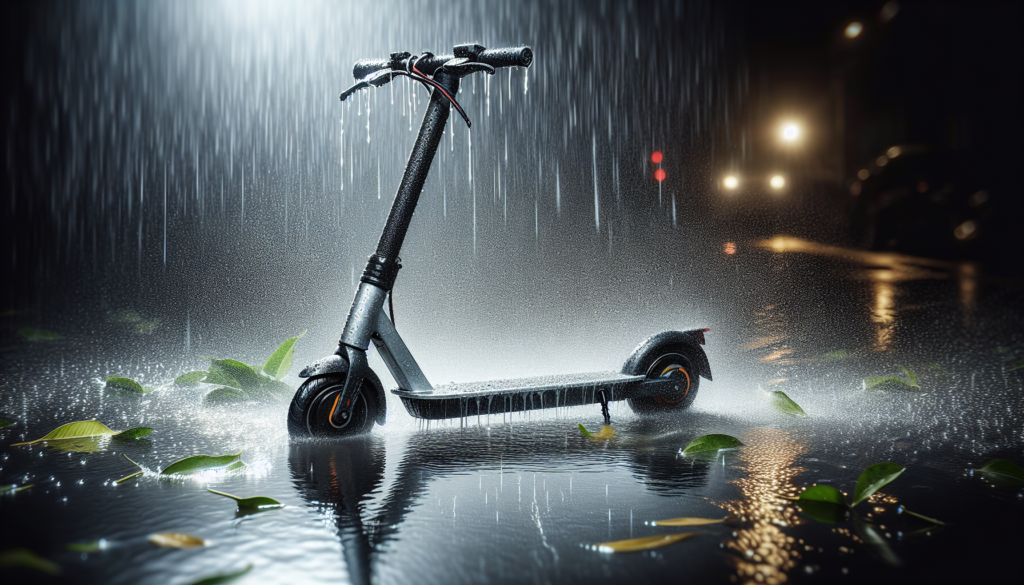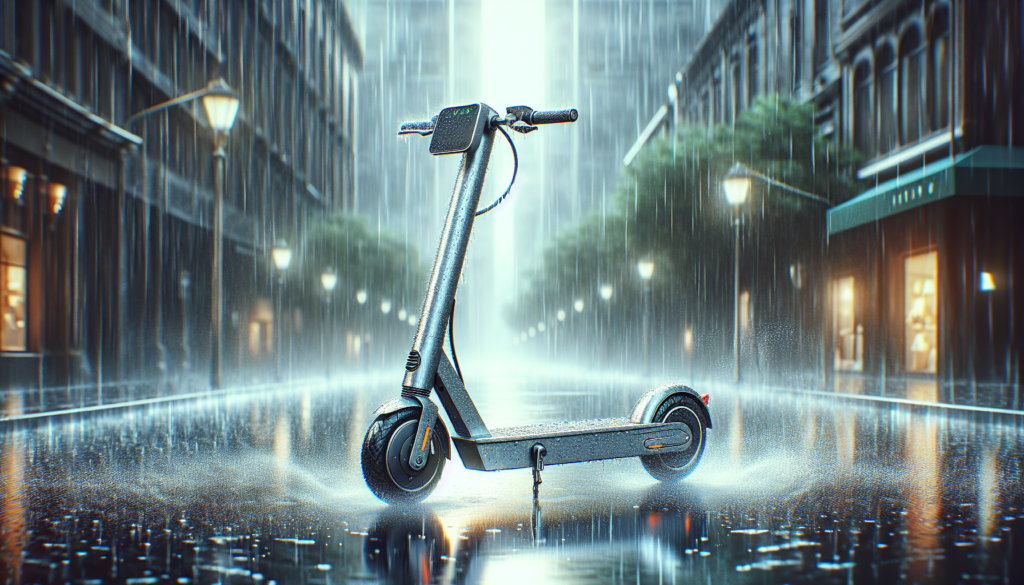So you’ve just purchased a sleek new electric scooter and you’re ready to take it out for a spin, but there’s one question on your mind: can electric scooters get wet? Well, you’ll be thrilled to know that electric scooters are designed to withstand some exposure to wet weather conditions. However, there are important precautions to keep in mind to ensure the longevity and performance of your scooter. In this article, we’ll explore how electric scooters fare in the rain, the necessary maintenance steps, and some handy tips for riding safely in wet conditions. Get ready to embrace the elements and enjoy your electric scooter rain or shine!
Can Electric Scooters Get Wet
Electric scooters have become a popular mode of transportation due to their convenience and eco-friendly nature. However, a common concern among scooter owners is whether their beloved electric scooters can withstand exposure to water. In this article, we will explore the topic of water resistance in electric scooters, the importance of IP ratings, the effects of water damage, and provide tips on how to prevent water damage and ensure the longevity of your electric scooter.

Water Resistance Ratings
To determine the water resistance capabilities of an electric scooter, one must understand the concept of IP ratings. IP stands for Ingress Protection and is followed by two numbers. The first digit indicates the level of protection against solid particles such as dust, while the second digit indicates the level of protection against water. Therefore, the second digit is the most crucial when considering the water resistance of your electric scooter.
Understanding IP Ratings
The second digit in an IP rating provides insight into the extent to which a scooter can withstand exposure to water. The ratings range from 0 to 8, with 0 meaning no protection against water and 8 indicating the highest level of water resistance. It is essential to remember that electric scooters with lower IP ratings may not be suitable for riding in wet conditions, as they are more susceptible to water damage.
Importance of IP Ratings
IP ratings are crucial in determining the water resistance capabilities of an electric scooter. Choosing a scooter with a higher IP rating offers peace of mind, knowing that it can withstand exposure to rain or splashes. However, it is important to note that even with a high IP rating, extensive exposure to water, particularly submerging the scooter in water, should still be avoided.
Waterproof vs. Water-Resistant
It is essential to understand the difference between water-resistant and waterproof when considering the water resistance capabilities of an electric scooter. Water-resistant means the scooter can withstand exposure to water to some degree, while waterproof indicates a higher level of protection against water. While many electric scooters claim to be water-resistant, it is essential to check the IP rating to understand how well it can withstand wet conditions.

Effects of Water Damage
Water damage can have severe consequences for electric scooters. Exposure to water can lead to electrical shorts, corrosion, and damage to sensitive electronic components. Furthermore, water damage may also affect the performance and safety of your electric scooter, compromising its durability and lifespan.
Common Water Damage Issues
When an electric scooter comes into contact with water, it can encounter various issues. One common problem is damage to the battery. Electric scooter batteries are not typically designed to be exposed to water, and even a small amount of moisture can damage or corrode the battery. Water damage can also cause issues with the scooter’s electrical system, speed controller, and motor, leading to decreased performance or complete failure.

Preventing Water Damage
While no electric scooter is completely waterproof, taking preventative measures can significantly reduce the risk of water damage. Here are some tips to help you protect your electric scooter from water-related issues:
- Avoid riding in heavy rain: Whenever possible, avoid riding your electric scooter in heavy rain to minimize exposure to water. If it starts raining unexpectedly, find shelter or carry a waterproof cover for your scooter.
- Use fenders: Fenders can help protect your scooter’s wheels from splashes and reduce the amount of water that comes into contact with internal components. Ensure that your electric scooter has adequate fenders installed.
- Dry your scooter: After riding in wet conditions, make sure to dry your electric scooter thoroughly before storing it. Use a dry cloth or towel to remove any moisture or water droplets, paying extra attention to the electrical components and connectors.
- Store your scooter properly: When not in use, store your electric scooter in a dry and covered area. Keeping it away from direct exposure to rain or other sources of moisture will help prevent water damage.
- Regularly inspect and maintain: Regularly inspect your electric scooter for signs of water damage, such as corrosion or rust. Additionally, follow the manufacturer’s recommended maintenance schedule to ensure your scooter remains in optimal condition.
Protective Covers and Bags
Using a protective cover or bag is an effective way to safeguard your electric scooter from water damage when storing or transporting it. Waterproof covers are specifically designed to shield your scooter from rain, dust, and other external elements. Look for covers that provide a snug fit and are made from waterproof materials to ensure maximum protection.

Maintenance and Care
Proper maintenance and care are essential for ensuring the longevity of your electric scooter, especially when it comes to water resistance. Along with regular inspections, here are some maintenance tips to keep your scooter in top shape:
- Keep electrical connections dry: Ensure that all electrical connections, including the charging port, are dry and free from moisture. If you notice any wetness, use a dry cloth or compressed air to remove the moisture.
- Apply silicone spray: Applying a thin layer of silicone spray on electrical connectors and exposed metal parts can help repel water and prevent corrosion. Be cautious not to spray directly on the braking system or any moving parts.
- Avoid power washing: While it may be tempting to power wash your electric scooter, it is best to avoid doing so. The high-pressure water can force its way into delicate components, causing damage. Stick to hand-cleaning methods instead.
Waterproofing Techniques
If you own an electric scooter with a lower IP rating and wish to enhance its water resistance capabilities, there are some additional techniques you can try:
- Silicone sealant: Applying a layer of silicone sealant to electrical connections and vulnerable areas can create an extra barrier against water. Be sure to disconnect any electrical connections before applying the sealant and allow it to fully cure before reconnecting.
- Waterproof sprays: Waterproof sprays designed for electronics can be used to add an extra layer of protection to your electric scooter. These sprays create a thin, water-repellent coating that can help prevent water damage.
- Aftermarket upgrades: Some manufacturers offer aftermarket waterproofing upgrades specifically designed for certain electric scooter models. These upgrades may include improved seals, gaskets, or waterproof covers to enhance the scooter’s water resistance capabilities. Consider checking with the manufacturer or authorized dealers for such options.
In conclusion, while electric scooters may have varying degrees of water resistance, it is crucial to understand their limitations and take appropriate measures to prevent water damage. By considering the IP rating, practicing good maintenance habits, and taking preventative measures, you can protect your electric scooter from harmful water exposure and ensure its optimal performance and longevity. Remember, a dry electric scooter is a happy electric scooter!


